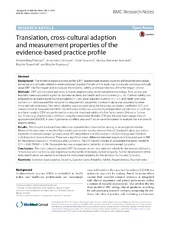Translation, cross-cultural adaption and measurement properties of the evidence-based practice profile
Titlestad, Kristine Berg; Snibsøer, Anne Kristin; Strømme, Hilde; Nortvedt, Monica Wammen; Graverholt, Birgitte; Espehaug, Birgitte
Peer reviewed, Journal article
Published version

Åpne
Permanent lenke
https://hdl.handle.net/1956/20538Utgivelsesdato
2017-01-13Metadata
Vis full innførselSamlinger
Originalversjon
https://doi.org/10.1186/s13104-017-2373-7Sammendrag
Background: The evidence-based practice profile (EBP2) questionnaire assesses students’ self-reported knowledge, behaviour and attitudes related to evidence-based practice. The aim of this study was to translate and cross-culturally adapt EBP2 into Norwegian and to evaluate the reliability, validity and responsiveness of the Norwegian version. Methods: EBP2 was translated and cross-culturally adapted using recommended methodology. Face validity and feasibility were evaluated in a pilot on bachelor students and health and social workers (n = 18). Content validity was evaluated by an expert panel. Nursing students (n = 96), social educator students (n = 27), and health and social workers (n = 26) evaluated the instrument’s measurement properties. Cronbach’s alpha was calculated to determine internal consistency. Test–retest reliability was evaluated using the intra-class correlation coefficient (ICC) and standard error of measurement (SEM). Discriminative validity was assessed by independent sample t test. A confirmatory factor analysis (CFA) was performed to assess the structural validity of a five-factor model (Relevance, Sympathy, Terminology, Practice and Confidence) using the comparative fit index (CFI) and the root mean square error of approximation (RMSEA). A priori hypotheses on effect sizes and P values were formulated to evaluate the instrument’s responsiveness. Results: The forward–backward translation was repeated three times before arriving at an acceptable version. Eleven of 58 items were re-worded. Face validity and content validity were confirmed. Cronbach’s alpha was 0.90 or higher for all domains except Sympathy (0.66). ICC ranged from 0.45 (Practice) to 0.79 (Terminology) and SEM from 0.29 (Relevance) to 0.44 (Practice). There was a significant mean difference between exposure and no exposure to EBP for the domains Relevance, Terminology and Confidence. The CFA did not indicate an acceptable five-factor model fit (CFI = 0.69, RMSEA = 0.09). Responsiveness was as expected or better for all domains except Sympathy. Conclusions: The cross-culturally adapted EBP2-Norwegian version was valid and reliable for the domains Relevance, Terminology and Confidence, and responsive to change for all domains, except Sympathy. Further development of the instrument’s items are needed to enhance the instruments reliability for the domains Practice and Sympathy.
